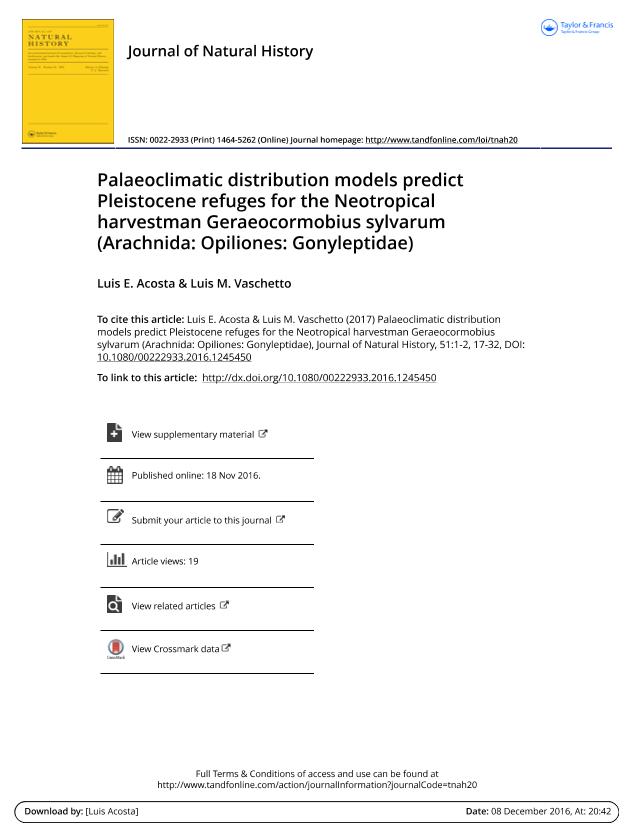Artículo
Palaeoclimatic distribution models predict Pleistocene refuges for the Neotropical harvestman Geraeocormobius sylvarum (Arachnida: Opiliones: Gonyleptidae)
Fecha de publicación:
01/2017
Editorial:
Taylor & Francis Ltd
Revista:
Journal of Natural History
ISSN:
0022-2933
Idioma:
Inglés
Tipo de recurso:
Artículo publicado
Clasificación temática:
Resumen
This paper primarily aims to test a Pleistocene refuge-type scenario, as previously proposed for the gonyleptid Geraeocormobius sylvarum, a semi-deciduous forests dweller in subtropical Argentina, Brazil and Paraguay. Palaeodistributional models of this species were built using MaxEnt for two Last Glacial Maximum (LGM = 21,000 years ago) simulations–Community Climate System Model (CCSM) and Model for Interdisciplinary Research on Climate (MIROC)–and for 6000 years ago (−6k = HCO, the Holocene climatic optimum). Both LGM models retrieved a fragmented pattern. For CCSM, range was split into multiple, scattered fragments. MIROC resulted in very few patches, with a decided range reduction because of a strong humidity drop. Models for −6k recovered a moderate range expansion. No past connection between the core area and the yungas was predicted. Analysis of variables importance showed that two precipitation predictors (bc18, precipitation warmest quarter; bc14, precipitation driest month) and two temperature predictors (bc7, temperature annual range; bc9, mean temperature driest quarter) scored as the most influencing overall. The Limiting Factor analysis recognized them as limiting too, in different parts of the species range. LGM palaeomodels of G. sylvarum are compatible with the refuge hypothesis invoked in previous molecular analyses, to explain the high genetic diversity found in the core area. Additionally, the results reinforced the hypothesis of the recent anthropogenic origin of the yungas disjunct populations.
Archivos asociados
Licencia
Identificadores
Colecciones
Articulos(IDEA)
Articulos de INSTITUTO DE DIVERSIDAD Y ECOLOGIA ANIMAL
Articulos de INSTITUTO DE DIVERSIDAD Y ECOLOGIA ANIMAL
Citación
Acosta, Luis Eduardo; Vaschetto, Luis Maria Benjamin; Palaeoclimatic distribution models predict Pleistocene refuges for the Neotropical harvestman Geraeocormobius sylvarum (Arachnida: Opiliones: Gonyleptidae); Taylor & Francis Ltd; Journal of Natural History; 51; 1-2; 1-2017; 17-32
Compartir
Altmétricas




